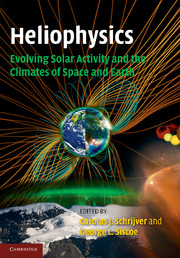Book contents
- Frontmatter
- Contents
- Preface
- 1 Interconnectedness in heliophysics
- 2 Long-term evolution of magnetic activity of Sun-like stars
- 3 Formation and early evolution of stars and protoplanetary disks
- 4 Planetary habitability on astronomical time scales
- 5 Solar internal flows and dynamo action
- 6 Modeling solar and stellar dynamos
- 7 Planetary fields and dynamos
- 8 The structure and evolution of the three-dimensional solar wind
- 9 The heliosphere and cosmic rays
- 10 Solar spectral irradiance: measurements and models
- 11 Astrophysical influences on planetary climate systems
- 12 Assessing the Sun–climate relationship in paleoclimate records
- 13 Terrestrial ionospheres
- 14 Long-term evolution of the geospace climate
- 15 Waves and transport processes in atmospheres and oceans
- 16 Solar variability, climate, and atmospheric photochemistry
- Appendix I Authors and editors
- List of illustrations
- List of tables
- References
- Index
- Plates
5 - Solar internal flows and dynamo action
Published online by Cambridge University Press: 05 April 2013
- Frontmatter
- Contents
- Preface
- 1 Interconnectedness in heliophysics
- 2 Long-term evolution of magnetic activity of Sun-like stars
- 3 Formation and early evolution of stars and protoplanetary disks
- 4 Planetary habitability on astronomical time scales
- 5 Solar internal flows and dynamo action
- 6 Modeling solar and stellar dynamos
- 7 Planetary fields and dynamos
- 8 The structure and evolution of the three-dimensional solar wind
- 9 The heliosphere and cosmic rays
- 10 Solar spectral irradiance: measurements and models
- 11 Astrophysical influences on planetary climate systems
- 12 Assessing the Sun–climate relationship in paleoclimate records
- 13 Terrestrial ionospheres
- 14 Long-term evolution of the geospace climate
- 15 Waves and transport processes in atmospheres and oceans
- 16 Solar variability, climate, and atmospheric photochemistry
- Appendix I Authors and editors
- List of illustrations
- List of tables
- References
- Index
- Plates
Summary
Magnetism with enthusiasm
As discussed in many chapters throughout these volumes, stars bristle with magnetic energy. They inherit some of their natural magnetism from their parent molecular clouds as they contract from protostellar cores (Chapter 3). However, stars are far from passive. After they ignite and enter the main sequence, much of their magnetism comes from within, bred by active hydromagnetic dynamos (Chapter 2; Vol. I, Chapter 3). Emerging magnetic flux influences the star's evolution and shapes its environment. It is the dissipation of magnetic energy in the solar corona that powers the solar wind, and the wind in turn carves out the heliosphere, a planetary cloister within the surrounding interstellar medium where the Sun holds sway. Magnetic fields originating in the solar interior permeate the heliosphere, weaving an intricate web with planetary magnetospheres and linking the Sun to the planets. The web changes continually as coronal mass ejections send sporadic bursts of magnetized plasma coursing through the heliosphere, restructuring fields and flows as they go.
Stars build magnetic flelds by tapping the energy in their own corporeal constitution. Thermonuclear fusion in their cores converts matter into thermal energy and electromagnetic radiation which, in the Sun, is transported outward via the diffusion of photons. In the solar envelope, the plasma becomes more opaque as the temperature drops, which inhibits radiative diffusion and steepens the temperature gradient relative to the adiabatic temperature gradient (Section 5.2).
- Type
- Chapter
- Information
- Publisher: Cambridge University PressPrint publication year: 2010



